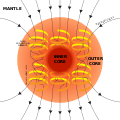Earth's core
The Earth's core is the part of Earth in the middle of our planet. It has a solid inner core and a liquid outer core. The temperature of the outer core ranges from 4400 °C in the outer regions to 6100 °C near the inner core.
Seismic measurements prove the core has two parts, a "solid" inner core with a radius of ≈1,220 km[1] and a liquid outer core extending beyond it to a radius of ≈3,400 km. The densities are between 9,900 and 12,200 kg/m3 in the outer core and 12,600–13,000 kg/m3 in the inner core.[2]
Outer core
The outer core of the Earth is a liquid layer about 2,400 kilometers thick. It is made of iron and nickel. This is above the Earth's solid inner core and below the mantle. Its outer boundary is 2,890 km (1,800 mi) beneath the Earth's surface. The transition between the inner core and outer core is about 5,150 km (3,200 mi) beneath the Earth's surface.
The temperature of the outer core ranges from 4400 °C in the outer regions to 6100 °C near the inner core. Eddy currents in the nickel iron fluid of the outer core are believed to influence the Earth's magnetic field. Convection in the outer core, combined with the Coriolis effect, gives rise to Earth's magnetic field. The solid inner core is too hot to hold a permanent magnetic field. It may stabilize the magnetic field generated by the liquid outer core.
The average magnetic field strength in the Earth's outer core is 25 Gauss, 50 times stronger than the magnetic field at the surface.[3][4]
Without the outer core, life on Earth would be very different. Convection of liquid metals in the outer core creates the Earth's magnetic field.[5][6] This magnetic field extends outward from the Earth for several thousand kilometers, and creates a protective magnetosphere around the Earth that deflects the Sun's solar wind. Without this field, the solar wind would directly strike the Earth's atmosphere. This might have removed the Earth's atmosphere, making the planet nearly lifeless. It may have happened to Mars.[7]
Inner core
The inner core of the Earth, was detected by Inge Lehmann using seismology. It is a solid sphere about 1,216 km (760 mi) in radius, or about 70% that of the Moon. It is believed to be an iron–nickel alloy, and may have a temperature similar to the Sun's surface, about 5778 K (5505 °C).
In 2015, Prof Xiaodong Song from the University of Illinois and other researchers in China suggested the inner core has two layers.[8] The seismic wave data suggests that crystals in the "inner inner core" are in an east-to-west direction. Those in the "outer inner core" are lined up north to south. Another scientist commented: "If this is true, it would imply that something very substantial happened to flip the orientation of the core to turn the alignment of crystals in the inner core north-south as is seen today in its outer parts".[8] Other scientists are checking their data.
Earth's Core Media
A photograph of Earth taken by the crew of Apollo 17 in 1972. A processed version became widely known as The Blue Marble.
Earth's crust and mantle, Mohorovičić discontinuity between bottom of crust and solid uppermost mantle
A diagram of Earth's geodynamo and magnetic field, which could have been driven in Earth's early history by the crystallization of magnesium oxide, silicon dioxide, and iron(II) oxide
References
- ↑ Monnereau, Marc; Calvet, Marie; Margerin, Ludovic; Souriau, Annie (May 21, 2010). "Lopsided growth of Earth's Inner Core". Science. 328 (5981): 1014–17. Bibcode:2010Sci...328.1014M. doi:10.1126/science.1186212. PMID 20395477. S2CID 10557604.
- ↑ Hazlett, James S.; Monroe, Reed; Wicander, Richard (2006). Physical geology : exploring the earth (6. ed.). Belmont: Thomson. p. 346. ISBN 978-0-495-01148-4.
- ↑ Bruce A. Buffett 2010. Tidal dissipation and the strength of the Earth’s internal magnetic field. Nature 468, 952-954. doi:10.1038/nature09643
- ↑ First measurement of magnetic field inside Earth's core. Science20.com. Retrieved on 2012-01-27.
- ↑ "Woodrow L. Shew, Daniel P. Lathrop 2005. Liquid sodium model of geophysical core convection. Physics of the Earth and Planetary Interiors 153 136–149" (PDF). Archived from the original (PDF) on 2011-07-18. Retrieved 2011-02-17.
- ↑ Kent C. Condie 1997. Plate tectonics, Butterworth-Heinemann; 4th ed. p140 ISBN 978-0750633864
- ↑ "Module title". ceo.scec.org.
- ↑ 8.0 8.1 Morelle, Rebecca 2015. BBC News Science & Environment. Heart of Earth's inner core revealed.




